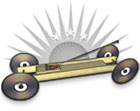Mousetrap Vehicles: Torque
An unbalanced torque is what causes a wheel to change its state of rotation. Learn all about torque and how it applies to the construction of a mousetrap vehicle.
Torque is the rotational counterpart to force, just as you applied a force to change an objects start of motion you apply a torque to an object to change its state of rotation. When you turn a faucet, open a door, or tighten a nut with a wrench you apply a torque. A toque is the perpendicular component of a force that is applied some distance from the point of rotation. The greater the torque applied to a rotating object the greater the change in its state of rotation. When you open a door you applied a torque, you either pull or push on the door and this causes it to rotate and open. Imagine if instead of pushing or pulling on the outside of the door you repositioned the handled closer to the hinge, because the radius is now smaller it will take a lot more force to open the door than compared to the normal situation.
τ = Fr
torque: a torque [τ] is equal to a force [F] applied a distance [r] from it's rotating center. Torque is measured in newton meters, force is measured in meters, and the radius is measured in meters.
Torque and Levers
In a balanced system the sum of the torque is always zero but in a system that is undergoing change the sum of all the torque will be equal to the change. A lever is a simple machine that has a fulcrum or a pivot and can be used to change the input and output forces. The idea with any lever system is that the torque on either side of the system will be the same but the distance the force is applied and the size of the force is different. Levers can be used to exert a large force over a small distance at one end by exerting only a small force over a greater distance at the other. The energy put into a lever is always the same energy you get out but what changes is the size of the displacing distance and the force. Levers are classified by the relative positions of the fulcrum and the input and output forces. It is common to call the input force the effort and the output force the load or the resistance. This allows the identification of three classes of levers by the relative locations of the fulcrum, the resistance and the effort.
- Class 1: The effort is applied on one side of the fulcrum and the resistance on the other side, for example, a crowbar or a pair of scissors or a seesaw.
- Class 2: The effort is applied on one side of the resistance and the fulcrum is located on the other side, for example, a wheelbarrow or a nutcracker.
- Class 3: The resistance is on one side of the effort and the fulcrum is located on the other side, for example, a pair of tweezers or the human mandible.
Mechanical advantage is a measure of the force amplification achieved by using a tool, mechanical device or lever.
MA = Foutput / Finput
mechanical advantage: the mechanical advantage [MA] is equal to the output force divided by the input force. All forces are measured in newtons.
Torque and Rotational Inertia
Torques are required to change the state of rotation for any rotating object. A toque is the perpendicular component of a force that is applied some distance from the point of rotation. With rotating objects we tend to talk about their angular speed or their angular acceleration. All rotating objects have a resistance to change that is called moment of inertia or rotational inertia. Rotational inertia is a rotational quantity that is similar in reference to the linear term of mass but depends on the location of the mass from the point of rotation. The more rotational inertia an object has the more torque that will be required to change it's state of rotation Just as forces cause objects to change their velocity torques cause objects to change their angular velocity.
τ = Iα
torque: a torque [τ] is also defined as the rotational inertia [I] of an object times the angular acceleration [α]. Torque is measured in newton meters, rotational inertia is measured in kilograms times meters squared, angular acceleration is measured in radians per second squared.
*Can't find what you're looking for? Ask Doc Fizzix »




